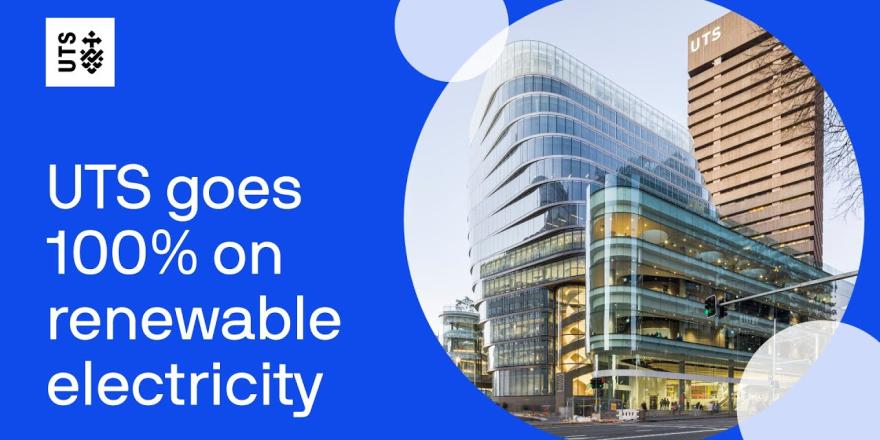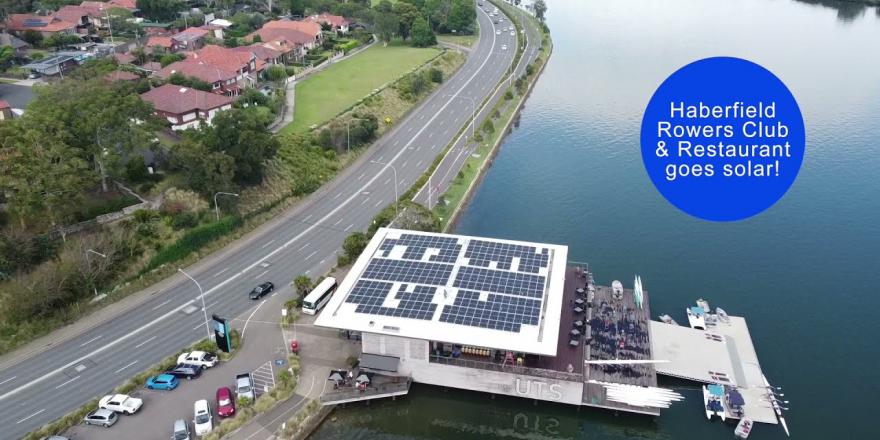The UTS Climate Positive Plan outlines targets and initiatives to help the university reach net zero for scope 1 and 2 emissions by 2025 and become carbon neutral by 2029. This will be achieved through sourcing 100% renewable electricity, transitioning away from fossil fuel use on campus and reducing energy wastage.

Intro
As part of the Climate Positive Plan and Sustainability strategy, UTS has committed to net zero for scope one and two emissions by 2025. A large part of this involves sourcing 100% renewable electricity, which we've now achieved, with all of our energy coming from solar and wind. Let's explore what this looks like in action.
Solar at UTS
The first step towards cutting down our reliance on fossil fuels was to generate some of our own energy from rooftop solar panels. UTS’s first onsite solar panels were installed in 2014, and since then, we've gradually added more and more panels to buildings on our main city campus, on Buildings 4, 6, and 10, with offsite locations like the Haberfield Rowing Club. UTS has also signed an innovative roof license agreement with the landlord of the Botany Tech Labs, and we've installed about 2000 solar panels there. We now have solar panels on all of our usable campus rooftops, so how can we cut down on our reliance on fossil fuels even further?
Beyond on-site solar
In 2015, UTS signed an Australia-first power purchase agreement with a solar farm in Singleton and another in Orange in 2017, in which these solar farms generate electricity for the grid, which UTS then purchases from the farms for fixed price. So these power purchase agreements supplemented UTS retail power use and establish the strategy, but we needed to do this on a larger scale to get UTS to 100%. UTS is now entered into long term renewable energy agreements to ensure that 100% of our electricity consumption is matched with generation
from wind and solar farms.
This means that with our rooftop solar, combined with these new agreements,
that UTS’s electricity is now coming from 100% renewable sources.
Battery Technology
Renewable sources can be intermittent. They only produce power when the sun is shining or the wind is blowing. So UTS is investing in battery technology to even out demand on the grid. The first of these batteries is being installed soon in Building 10.
Electrifying our Campus
It's not enough for UTS to just source its electricity from renewable sources. We also need to transition away from fossil fuel use on campus. to achieve this, no new buildings will be connected to gas, and UTS is commencing a program to electrify the space and water heating on campus, decreasing our reliance on natural gas and contributing towards our goal of achieving net zero for scope one and two emissions by 2025 and climate positive by 2029.
100% Renewable electricity
UTS is now sourcing all of its electricity from renewable energy through onsite roof top solar panels and by entering into long term renewable electricity agreements to ensure that all of our electricity consumption is matched by equivalent renewable generation from wind and solar farms. This means that by the end of 2025, all of UTS’s electricity will be matched to renewable sources. UTS is also investing in battery technology to even out our demand on the grid with the first of these batteries being installed in building 10. Find out more.
In 2024, 33% of our energy came from renewable sources, equating to 14,836 MWh (53,409 GJ).
Solar Panels
In 2014, UTS installed our first onsite solar panels. Since then, we have added more and more panels to the buildings on our main city campus, as well as off campus locations including the Haberfield Rowing Club. In 2020, UTS signed an innovative roof license agreement with the landlord of our Botany Tech Labs and we have now installed 1970 panels on this site.
So far our solar projects include:
| INSTALLATION | NUMBER OF PANELS | CAPACITY | DATE |
|---|---|---|---|
| Building 11 roof top | 72 panels | 21.6 kW | 2014 |
| Orange solar farm | 242 panels | 60 kW | Contract with Pentagon Generation, 2017 |
| Yura Mudang student housing, Building 6 | 86 panels | 28 kW | 2017 |
| Building 4 | 224 panels | 73 kW | 2017 |
| Aerial Function Centre, Building 10 | 426 panels | 127 kW | 2017 |
| UTS Rugby Australia | 240 panels | 64 kW | 2017 |
Haberfield Rowing Club Botany Engineering Facility Total capacity | 223 panels 1970 panels 3483 panels | 99 kW 782 kW 1254.6 kW | 2020 2020-23 2025 |

No script
Electrification
UTS also needs to transition away from the use of fossil fuels on campus. To achieve this, no new buildings will be connected to gas and UTS has begun electrifying space and water heating on campus to reduce our reliance on gas.
Energy efficiency
UTS monitors our energy usage with a network of meters across individual floors in all buildings to identify faults and energy leakage in real time. We conduct quarterly reviews to continually improve energy efficiency.
In addition, UTS conducts fortnightly building optimisation meetings between the Facilities Management, Engineering and Sustainability teams to coordinate energy efficiency projects. Some of the key projects currently being undertaken to identify and reduce energy wastage include:
- We are working with our internal AI team and external building analytics platforms to predict when a building's peak electricity demand is likely to occur. Preventative actions are then undertaken such as pre-cooling buildings during periods of low demand, reducing UTS's peak demand and energy spend. This also reduces the strain on the electricity grid shifting demand to periods to when the grid is being predominantly supplied by renewables;
- Multiple Building Management System (BMS) optimisation projects are currently underway such as using BMS analytics to suggest corrective actions that can reduce energy wastage.
- A master plan has been commissioned to electrify all fossil fuels used for domestic hot water and space heating on campus. This will eliminate the use of fossil fuels being burnt and heat water much more efficiently.
- Building audits have been conducted to identify opportunities for LED upgrades. These upgrades as well as optimising lighting control strategies are currently being rolled out across campus. UTS has a plan to improve energy efficiency and reduce consumption.
The comprehensive UTS Design Guidelines help ensure all renovations and new buildings continually improve energy efficiency standards across the campus.
In 2021 we achieved our target to reduce green house gas emissions by 30% based on 2007 levels. See more details here.
What you can do
- Turn off computers and monitors at the end of the day or when not in use
- Choose natural light as much as possible, only turn on lights when necessary
- Switch off lights as you leave empty rooms
- Take the stairs instead of the lift
- Choose CFL and LED bulbs for desk lamps
- Turn off all machinery and lab or kitchen equipment when not in use
- Don’t boil an entire kettle for one cup
- Report faulty lighting and equipment by emailing maintenance.request@uts.edu.au
- Spread the word to friends and colleagues about not wasting energy.
Useful links
- Your Home is an award guide, published by ISF in collaboration with the Commonwealth Government and provides lots of great advice on sustainable housing to householders and building professionals including energy use
- Department of Climate change and Energy Efficiency provides information about climate change initiatives in Australia and actions you can take to reduce your greenhouse gas emissions
- Department of Environment and Energy provides information on how to save energy, reduce your energy bills and make your home more comfortable

